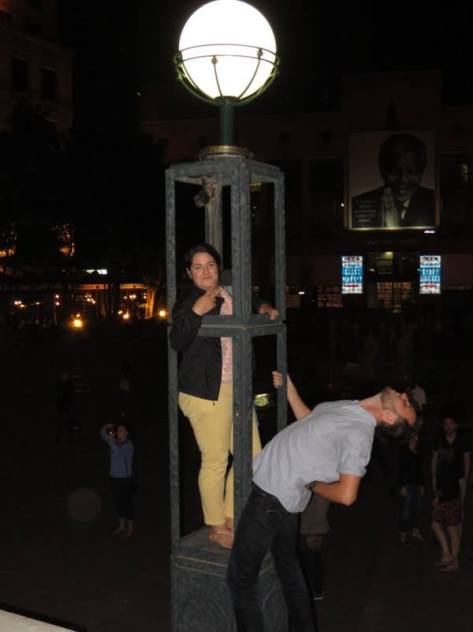One week in early April, as the warmth of summer in Cape Town began to drift away and the rainy, cloudy days of autumn began to appear with more frequency, the UConn in Cape Town students headed north to Gauteng Province for an excursion to the heart of South Africa.
This week long trip would take us out of the Cape Town milieu for the first time and thrust us knee-deep into South Africa’s bustling capital, home to so much history and cultural vibrancy. Reflecting upon this excursion, I remember how it challenged my understanding of modern South African society, which had been formed exclusively through my experiences in and around Cape Town, a city that I would come to learn did not begin to represent the whole of South Africa at all. In such a large, varied, and complex country, this should not have been a surprise.
Joburg’s history is full of toil and triumph, exploitation and uprisings, gold and platinum, violence and victories. It’s a place where life is cheap and living is dangerous, but it’s the center of all the action. Joburg glitters with skyscrapers and casinos, luxury malls and sprawling estates, high-end car dealerships and advertisements on the highway median; it’s a place of sprawling township communities, massive apartment blocks harboring secrets that I won’t ever see, and office towers and hotels sitting vacant and crumbling; where the streets downtown bustle during the day like New York City, yet are empty and quiet with risk at night; where mine dumps rise up like yellow mountains over hills and homes, and the railcars, streets and shebeens are the scenes of countless crimes committed to history in novels and plays.
Johannesburg is not Cape Town; it’s a whole other animal. Joburg is the epicenter of Southern Africa, the hub of power, money, and law. While Cape Town clings to the edge of the country down on one corner of the Cape, all roads lead to Joburg, a city built atop gold deposits so lucrative that they shaped the history of entire nations and peoples. While Cape Town’s population can be largely split into three (arbitrary) racial groups, Colored, Black, and White, there’s no such reductionism in Joburg. Every racial group is represented in numbers in the city, along with migrants from every nation in Africa and beyond. While Cape Town is ruled by the Democratic Alliance, Joburg is all ANC, and is the city where Mandela lived and worked for so many years, first as a runaway from his tribal community in the Transkei, then as a lawyer, activist, revolutionary, prisoner, and president.
With no small amount of trepidation, my classmates and I packed our suitcases and embarked on the grimly foreboding process of leaving Cape Town by plane. This day’s journey wouldn’t be back to the United States, however; we were flying now to Lanseria Airport, east of Johannesburg in Gauteng Province.
On the ride to our hotel in Sandton, I was struck by how different Joburg looked from Cape Town. We drove through miles of sprawl, residential, commercial, and industrial areas, but it was a stark departure from Cape Town’s miles-long view of shacks that one sees upon arrival from the airport. Where Cape Town is flat and primarily sandy, Joburg is situated among rolling hills, not unlike Rome, and covered with trees and bush. As our bus pulled off the congested highway and onto the offramp, I swore for a second that I saw people down below, a fire burning away here and a shack there, a community hidden on the periphery of South Africa’s economic and business capital.
When Joburg proper “choked and died” in the early 1990s as hundreds of thousands of impoverished black South Africans moved into the city and whites (and their money) flew out, the financial and business operations of South Africa’s capital migrated to Sandton, a few miles north of downtown Joburg. Downtown Joburg became a realm of abandoned office towers and hotels, concentrated poverty, and limited economic opportunity, while Sandton became the new seat of wealth and power.

Our first evening in Joburg was spent at Nelson Mandela square, where we had dinner at a lovely steak restaurant and frolicked afterwards among fountains in the square, safely ensconced in what is undoubtedly a playground for the rich. During my first day or so of visiting Johannesburg, I was somewhat discontented by the fact that we were staying in safe and staid Sandton, instead of staying in the middle of the action in downtown Joburg. The truth, I would later learn, is that while downtown Johannesburg has been home to an economic and cultural revival in recent years, the downtown I was looking for was not in Joburg, but rather in Sandton, Newtown, Parkhurst, Norwood, and elsewhere. My lessons about Johannesburg, and South Africa on the whole, had only just begun.
I promise the next post will actually detail some of the places we visited and things we experienced. Promise! I have pictures.


